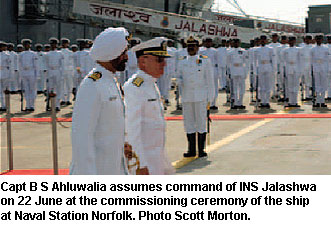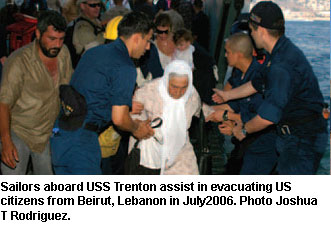|
It is the same answer for the highly sophisticated Northrop Grumman's Hawkeye II, the all-weather carrier based Tactical Airborne Early Warning Aircraft, but for different reasons.
According to informed sources here, the USS Nashville, listed in the US Navy as an Austin-class Amphibious Transport Dock, had indeed been examined by Indian naval officers, "but that there was no movement on the US offer."
A second Trenton-type vessel would be an important asset for the Indian Navy to give it the capability to touch shores to land heavy equipment from tanks and troops to relief material in situations like a natural disaster or tsunami, but apparently the naval brass wants to see how the Trenton, now called INS Jalashva, helps boost the Indian Navy's capabilities in the Indian Ocean.
As for the Hawkeye II, sources here and in New Delhi said that the technology on board this aircraft was "tempting" but the Indian Navy cannot acquire it for the simple reason that its launch and recovery system is different than what would be available on board India's indigenously-developed carriers or INS Vikramaditya (Admiral Gorshkov) that India is buying from Russia.
Indian Navy's carriers have ramps for short-take-off-and-landing while the US carriers use steam-powered catapults and arrester wires.

Of course, one could use the Hawkeye for shore-based operations but then, for that role, the Indian Navy is already looking at other Maritime Reconnaissance aircraft like Boeing's P-8I.
Jalashva left the US shores from the Naval Station Norfolk, Virginia or August 1 and is due to reach Mumbai on Monday, September 10. Its departure was delayed slightly as the Navy had to refurbish the vessel to the best possible state. It was taken over from the US Navy in January and formally commissioned as INS Jalashva on 22nd June at Norfolk itself.
The ship will shortly set sails from there for the Eastern Naval Command at Vishakhapatnam, where it will be deployed for operational requirements on India's eastern seaboard.
Before its departure, US sailors gave appropriate training to their Indian counterparts in handling the equipment and emergencies, which are bound to arise whenever there are hostilities. The vessel took part in relief and evacuation efforts in the trouble-torn Lebanon in July 2006, and some Indians were also associated at that time to familiarize themselves with its capabilities.
Naval sources in New Delhi said that the Indian Navy had acquired a multi-role vessel like the INS Jalashva for the first time and that "it would be appropriate to assess how it fits in with our options before any more acquisitions."
"The Navy needs all kinds of ships and another vessel like Jalashva would certainly be welcome but let's have our experience first-hand first," sources told India Strategic.
 USS Nashville is listed as Landing Platform Dock (LPD) 13 in the US naval list while the Trenton was marked as LPD 14.
The US Navy itself is moving to another class of ships for LPD role and according to informed sources, the newer vessels could also be available to India if India expressed interest.
INS Jalashva meanwhile has been fully refurbished to the Indian Navy's requirements. Its most potent weapon, two Phalanx guns had been "optimized" to a near original state along with their radar by Raytheon, the leading defence systems company which does not make platforms like aircraft, ships or tanks but gives them lethality through its weapon systems.
Admiral Walter Doran, Raytheon's President for Asia, said that his company had the US government clearance to supply the newer versions of the Phalanx gun not only for the INS Jalashva but for other Indian naval ships as well.
An offer had appropriately been conveyed to the Indian Navy.
Phalanx is the main Close-In Weapon Support (CIWS) system on most of the US warships to protect them from a variety of threats, including Exocet type sea-skimming missiles. It fires 3000 rounds/minute of very hard non-radioactive depleted uranium shells.
Six refurbished Sikorsky UH-3 heavy lift helicopters are also on board the INS Jalashva, now the Indian Navy's second largest vessel after the ageing aircraft carrier INS Viraat.
Viraat is due to be phased out as soon as Vikramadiya arrives from Russia within a couple of years.

The 17000-ton Jalashva, commanded by Capt B S Ahluwalia, has a complement of about 300 sailors and 30 officers. It has been assigned to the Eastern Fleet, headed by Rear Admiral Robyn Dhowan, and will be based at Vishakapatnam, which will be its home port.
It may be noted that during the 2004 Tsunami, the Indian Navy had near-zero capability for amphibious operations as its ships could not touch the debris-littered shores of affected coastal areas in India or in the neighbouring countries where it offered immediate help.
The Indian Navy committed around one-fourth of its resources but even that was not enough. It just could not reach the shores without great effort.
The government then moved fast to clear the acquisition of USS Trenton when the US offered it to India under its Foreign Military Sales (FMS) programme.
It may be noted that in every disaster, the Indian Army, Navy and Air Force are deployed to provide relief to the affected people and all the three services, starved of even war fighting equipment from 1990 onwards, are asking for adequate equipment.
Senior officers from the three services point out that soldiers work 24 hours whenever called for but for the last 27 years, the process even to replace worn out and outdated equipment for war fighting or relief - even like amphibious vehicles to transport aircraft and helicopters - had been crippled till the 1999 Kargil war. |